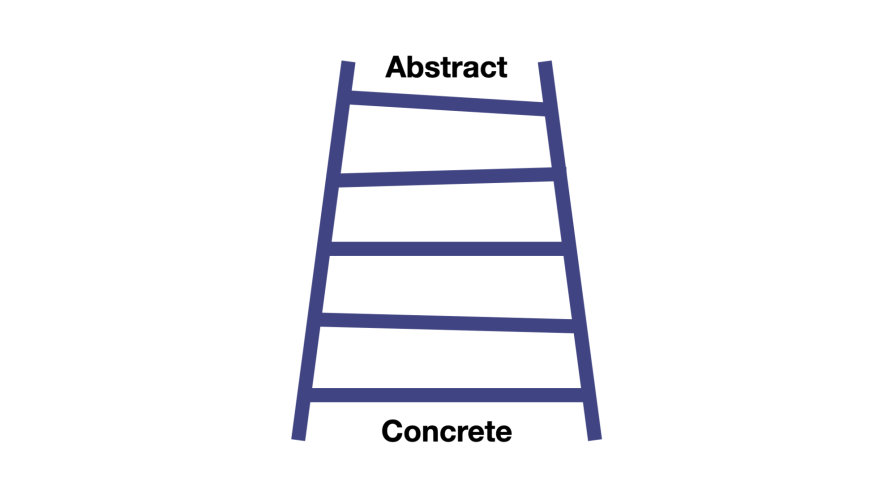Have you ever had the experience of sitting in a meeting where the conversation seemed stuck in the clouds, full of grand visions but lacking any concrete steps to get there? Or perhaps you’ve been in the opposite situation, bogged down in minute details without any clear sense of the bigger picture?

As a product manager, you need to strike the right balance between high-level strategic thinking and detailed execution to drive your product’s success. Luckily, the “ladder of abstraction” can help you do just that.
This article explains how you can leverage the ladder of abstraction to construct more effective messages and find a balance between high-level visions and practical actions.
The ladder of abstraction is a concept used to illustrate the range of thinking from the abstract (top of the ladder) to the concrete (bottom of the ladder). Linguist S.I. Hayakawa introduced this concept in his book “Language in Thought and Action.” The idea is that at the top of the ladder, you have more abstract terms, and as you move down, terms become more concrete.
This helps in understanding how language and thought interact and how you can communicate more effectively by choosing the appropriate level of abstraction. The ladder can also be used as a framework that helps balance high-level concepts and specific details:

The bottom of the ladder consists of concrete items. These are “grounded” and “down to earth” as illustrated in the image. Think of specific, tangible facts such as your favorite restaurant or the highway you take everyday.
In an office setting, concrete items can be:
On the other hand, the top of the ladder consists of more abstract ideas and concepts. These are more general and tend to be philosophical such as concepts like freedom, well-being, or happiness.
In an office setting, on the top of the ladder, the abstract ideas can be:
Moving up or down the ladder requires different actions. To help you get started, consider the following:
Although staying on the top of the ladder can sound inspirational and motivational, you should ensure the product plan isn’t superficial and hollow. While brainstorming, ask “how” questions to move down the ladder and be more specific:
Also, when available, cite data and statistics to set baselines and make the goal measurable. Providing examples is also a good way to help the team be on the same page.
In brainstorming, presentations, meetings, or any situations, ask “why” questions to move up the ladder and tie the actions back to the high-level vision and objectives. Also, by asking the “why” questions, the audience understands the rationale behind the actions and sees the bigger picture. Here are some “why” questions in the product management context:
To communicate effectively, you need to climb up or down the ladder of abstraction while speaking. You should plan strategically (abstract) with actionable items (concrete) when working on products. Sticking on either side of the ladder can harm the growth of the product.
A good PM finds a balance between abstract and concrete in product planning. You might wonder what happens when you get caught on one side of the ladder. Either side poses its own set of problems:
At the top of the ladder, you deal with abstract concepts such as the overall vision, mission, and goals. This high-level thinking involves understanding market trends, customer needs, and the competitive landscape. However, what may be the side effect if you only focus on this level?
One of your most important tasks as a PM is translating the vision into actionable items. As PMs move down the ladder, they tend to focus on more specific elements such as product features, user stories, and technical requirements. However, you don’t want to fall into the trap of thinking too concrete. Here are the problems you may be facing if you’re stuck at the bottom of the ladder:
By navigating up and down the ladder, you can ensure that your teams are strategically aligned and equipped with the detailed guidance necessary to execute their vision.
Ultimately, product management is the art of finding the balance. This section shows how you can remain concrete while still having abstract thoughts:
With the ladder of abstraction, you can navigate between abstract ideas and concrete details with ease. This approach not only enhances clarity and alignment across your team, but also ensures that innovative ideas are grounded in practical implementation.
Try to incorporate the ladder of abstraction into your daily routine until it becomes second nature. Good luck! Report back with any comments or questions you have.
Featured image source: IconScout
LogRocket identifies friction points in the user experience so you can make informed decisions about product and design changes that must happen to hit your goals.
With LogRocket, you can understand the scope of the issues affecting your product and prioritize the changes that need to be made. LogRocket simplifies workflows by allowing Engineering, Product, UX, and Design teams to work from the same data as you, eliminating any confusion about what needs to be done.
Get your teams on the same page — try LogRocket today.

Trey Courtney talks about his process for evaluating partnerships or acquisitions and how he successfully implements these initiatives.

Asma Syeda shares the importance of responsible AI and best practices for companies to ensure their AI technology remains ethical.

What hard skills do PMs need in 2025? Learn how AI tools can help you level up in SQL, Figma, A/B testing, and more.

Paul Weston talks about “quantifying the unquantifiable,” i.e., bringing in objective data for things that otherwise seem hard to measure.